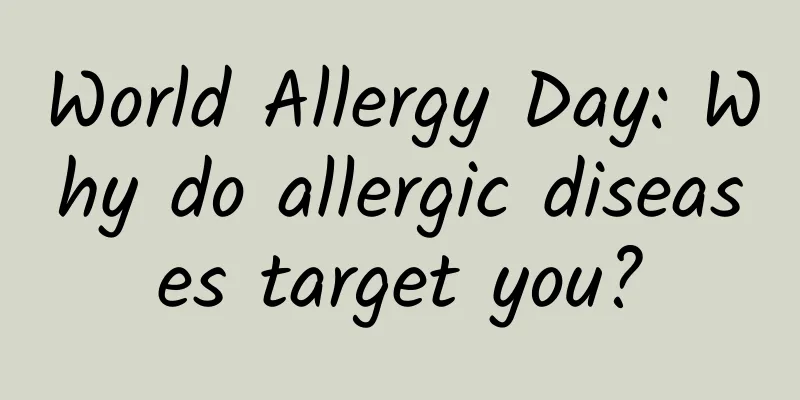How can patients with rhinitis save themselves during the transition from autumn to winter?

|
I believe that there are always a few people with rhinitis around you. When you go to work or class in the morning, you can always hear the sound of people blowing their noses. When you turn around, you will see that the other person's nose has been poked red, his mouth is slightly open, and he sighs deeply. In fact, for patients with rhinitis, this is just something they experience every day, especially during the transition from autumn to winter. Rhinitis often occurs when the seasons change, when you stay in an air-conditioned room for a long time, or when you catch a cold... Rhinitis is often caused by a cold. Some pollen-like irritants directly stimulate the nasal cavity, so it is not surprising that the struggle between good and evil in the nose is aroused. What we often call rhinitis refers to inflammatory diseases of the nasal cavity, which is an inflammation of the nasal mucosa caused by viruses, bacteria, allergens, various physical and chemical factors, and certain systemic diseases. It can be divided into allergic rhinitis and allergic rhinitis. Allergic rhinitis is a non-infectious chronic inflammation of the nasal mucosa after contact with dust mites, pollen, etc., and is manifested by sneezing, nasal congestion, etc. Allergic rhinitis, also known as allergic rhinitis, is one of the common diseases in the Department of Otolaryngology. According to data from the World Health Organization (WHO), there are nearly 600 million patients with allergic rhinitis worldwide. The main symptoms of rhinitis are: nasal congestion, excessive mucus, decreased or lost sense of smell, headache, dizziness, loss of appetite, fatigue, memory loss and insomnia. Chronic rhinitis can cause long-term intermittent or alternating nasal congestion, leading to dizziness and headache. In the first 1 to 2 days of acute rhinitis, patients will experience dryness in the cavity and nasopharynx, frequent sneezing, etc. During the acute phase from the 2nd to 5th day, vomiting, diarrhea, coma and even convulsions will often occur. If you blow your nose incorrectly, these bacteria and viruses will go to places they shouldn’t go! On the other hand, incorrect nose blowing posture may cause otitis media, nosebleeds and sinusitis. The correct way is to place toilet paper or handkerchief in front of both nostrils; press one nostril, exhale with a little force to wipe out the snot; then use the same method to clean the nostril on the side that was just pressed. If I don't blow my nose, can't I just suck it? Of course not. There may be viruses, dust, etc. in the snot, and our goal is to expel them from the body; in addition, if you inhale the mucus, it may enter the trachea by mistake, and even cause suffocation, which is very dangerous. How can patients with rhinitis save themselves? You can pay attention to whether you have been exposed to indoor and outdoor allergens, keep the air circulating indoors, pay attention to temperature changes, and always keep your nose warm. There are some nasal irrigation products on the market that claim to be good news for rhinitis patients. But are they really effective? Will the nasal cavity become more serious the more it is rinsed? Dongdongmiao also wants to say this: as long as the method is used correctly, there is no danger in washing your nose. Nasal irrigation can wash away irritants and allergens such as dry scabs, pollen, and dandruff attached to the nasal mucosa, which is conducive to other nasal medications to better act on the nasal mucosa and diffuse, thereby improving the overall treatment effect. However, it should be noted that people with acute nasal infection and bone defects in the skull base and orbital wall and patients with severe anterior deviation of the nasal septum cannot undergo nasal irrigation. As for the frequency of flushing, it is generally 1 to 2 times a day. For patients with allergic rhinitis, flushing can be performed after contact with allergens. There are special nasal washers in major hospitals or regular pharmacies, which can be used according to the instructions. Produced by: Dongdongmeow Public account: Dongdongmeow Science (ID: dongdongmeow) Video account: Dongdongmiao; Weibo: @Dongdongmiao Science First published: Science Popularization China Science Popularization Account "Dongdong Miao" |
<<: What should not be eaten with straw mushrooms (it will cause adverse reactions with quail meat)
Recommend
Will low estrogen cause menopause?
I believe that everyone knows in daily life that ...
Uneven echo in the uterine cavity after medical abortion
Medical abortion is also a way to terminate pregn...
What to do if you are infertile after one year of marriage?
Many women want to have their own children after ...
Why do small flying insects like to fly into the eyes? Why are eyes called "eyes"?
We often say that eyes are the windows to the sou...
Can metronidazole cure cervical erosion for the second time?
Cervical erosion is very harmful to patients. It ...
Identify the "master of disguise" and dispel the misunderstanding of influenza
It's the flu season again, and everyone hopes...
What should I do if my girlfriend has menstrual period and stomach pain
Menstruation is something that women will experie...
What are some weight loss exercises for women?
Exercise to lose weight is a job that many people...
Why is it better to eat cashews cooked? Nutritional information of cashews
Cashews are one of the four famous dried fruits, ...
Endometrium still present after one week of medical abortion
Medical abortion is actually one of the methods o...
Six keywords about elegance that women should know
For me, transforming ordinary women into elegant ...
How to eat to lose weight during menstruation? Recommend four dietary therapies
Menstruation is a special stage for women, and di...
Can pregnant women soak their feet when they have a cold?
Pregnant women must pay close attention to their ...
Will sex affect menstruation?
A woman's ovaries ovulate once a month. If th...
What is the cause of vomiting yellow bitter water during pregnancy?
Women will have some pregnancy reactions during p...









